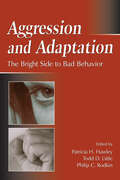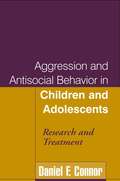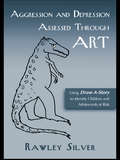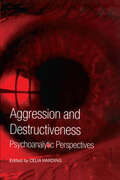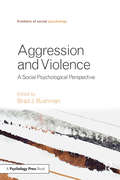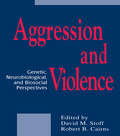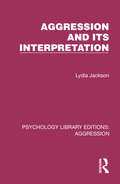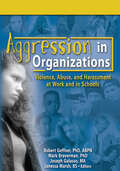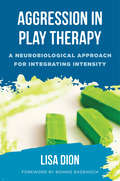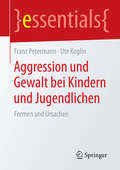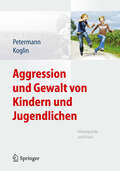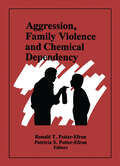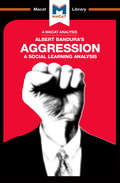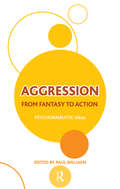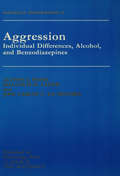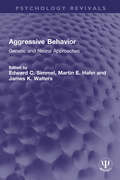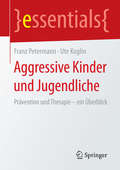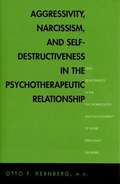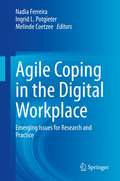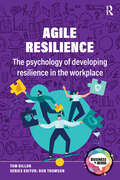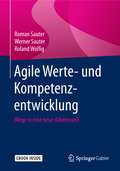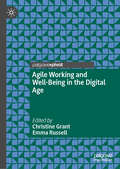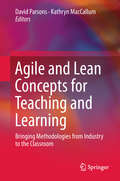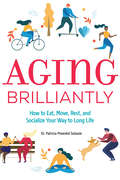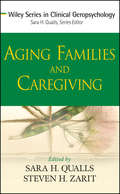- Table View
- List View
Aggression and Adaptation: The Bright Side to Bad Behavior
by Todd D. Little Patricia H. Hawley Philip C. RodkinAggression and Adaptation raises thought provoking questions about interpersonal functioning within social groups. The reader may find him/herself entertaining thoughts about the nature of goodness as the chapters suggest that aggressive behavior can offer significant avenues for personal growth, goal attainment, and bolstering one's social st
Aggression and Antisocial Behavior in Children and Adolescents
by Daniel F. ConnorThis comprehensive volume reviews and synthesizes a vast body of knowledge on maladaptive aggression and antisocial behavior in youth. Written from a clinical-developmental perspective, and integrating theory and research from diverse fields, the book examines the origins, development, outcomes, and treatment of this serious problem in contemporary society. Major topics addressed include the types and prevalence of aggressive and antisocial behavior; the interplay among neuropsychiatric, psychosocial, and neurobiological processes in etiology; known risk and protective factors; gender variables; and why and how some children "grow out of" conduct disturbances. Chapters also discuss current approaches to clinical assessment and diagnosis and review the evidence for widely used psychosocial and pharmacological interventions.
Aggression and Depression Assessed Through Art: Using Draw-A-Story to Identify Children and Adolescents at Risk
by Rawley SilverA study of more than two hundred children using Rawley Silver's draw a story test showed a strong correlation between aggression or depression and certain types of artistic narratives; meanwhile, unbeknownst to Silver, a pair of Russian therapists were using Silver's assessment tests in a similar fashion with Russian children and achieving similar results. Aggression and Depression Assessed Through Art: Using Draw-A-Story to Identify Children and Adolescents at Risk came about as a result of these studies, but the book's scope goes beyond the numbers to investigate the connections between a child's expression through drawing and his violent behavior. The text, written mostly by Silver but with chapters contributed by therapists from both the United States and Russia, compares drawings by children who have already exhibited violent behavior with those who have not, thus exploring the potential of the test for use as an early identifier of children and adolescents at risk for depression or inappropriate aggression. Other chapters examine the changes in emotional state revealed by a child's responses to standard art assessment tests, as well as the cross-cultural applications of Silver's tests. Silver is recognized as one of the earliest developers of art therapy in the United States, and by providing mental health professionals with a tool to help identify and treat disturbed children this book represents yet another of her major contributions to the field.
Aggression and Destructiveness: Psychoanalytic Perspectives
by Celia HardingWhy, when and how does aggression go wrong? How can we make sense of apparently meaningless destructiveness and violence Aggression is a part of human nature that energises our relationships, acts as an impetus for psychic development, and enables us to master our world. More often, we focus on its more destructive aspects, such as the violence individuals inflict on themselves or others and overlook the positive functions of aggression. In Aggression and Destructiveness Celia Harding brings together contributions from experienced psychoanalysts and psychoanalytic psychotherapists to explore the roots of aggression and the clinical dilemmas it presents in psychotherapy. Beginning with accounts of aggression and destructiveness from a range of developmental and theoretical perspectives, the book provides useful insights into subjects including: Bullying and abusive relationships Male and female violence and destructiveness Depressive, perverse and psychotic states of mind Attacks on therapeutic treatment This book makes a valuable contribution to the attempt to make sense of human aggression, destructiveness and violence perpetrated against the self, others and reality. It will be of great interest to trainee and qualified psychodynamic counsellors, psychoanalytic psychotherapists and psychoanalysts.
Aggression and Violence: A Social Psychological Perspective (Frontiers of Social Psychology)
by Brad J. BushmanThis book provides a broad and contemporary overview of aggression and violence by some of the most internationally renowned researchers in the field. It begins with an integrative theoretical understanding of aggression and shows how animal models shed light on human aggression and violence. Individual risk factors for aggression and violence from different research perspectives are then examined. First, there is a cognitive neuroscientific, neuropsychological, and psychophysiological study of the brain. It then explores the developmental psychological factors in aggressive behavior, incorporating work on gender and the family. Other perspectives include the role of testosterone, individual differences, and whether humans are innately wired for violence. The following sections moves from the individual to the contextual risk factors for aggression, including work on the effects of adverse events and ostracism, guns and other aggressive cues including violent media, and drugs and alcohol. Targets of aggression and violence are covered in the next section, including violence against women and loved ones; aggression between social groups; and the two very contemporary issues of cyberbullying and terrorism. The book concludes with work showing how we may make the world a more peaceful place by preventing and reducing aggression and violence. The volume is essential reading for upper-level students and researchers of psychology and related disciplines interested in a rigorous and multi-perspective overview of work on aggression and violence.
Aggression and Violence: Genetic, Neurobiological, and Biosocial Perspectives
by Robert B. Cairns David M. StoffConceived at a time when biological research on aggression and violence was drawn into controversy because of sociopolitical questions about its study, this volume provides an up-to-date account of recent biological studies performed -- mostly on humans. A group of scientists recognized the importance of freedom of inquiry and deemed it vital to address the most promising biological research in the field. The focus on biological mechanisms is not meant to imply that biological variables are paramount as a determinant of violence. Rather, biological variables operate in conjunction with other variables contributing to aggression or violence, and a complete understanding of this phenomenon requires consideration of all influences bearing on it. This book will familiarize readers with the rapidly growing and increasingly significant body of knowledge on the biological bases of human antisocial, aggressive, and violent behaviors. The editors concentrated on biological influences that support the basic physiological and biochemical processes of the brain and did not cover those biological influences that impact on the health of the individual such as head injury, pregnancy and birth complications, diet, and exposure to lead and other toxins. They focused on biological influences to illuminate their role in the complex behavioral phenomenon of violence. Three different approaches to the biological study of human antisocial, aggressive, and violent behaviors are represented -- genetic, neurobiological, and biosocial. Representing each of these three approaches, individual chapters from investigators in psychobiology, biological psychiatry, and basic-clinical neurosciences address the most recent experimental findings, methods, theory, and common misconceptions in the biological study of aggression and violence. The areas of primary focus are behavior and molecular genetics, neurochemistry and hormones, neuroimaging, psychophysiology and developmental psychobiology. Generally speaking, investigators following these different approaches have experience in different scientific backgrounds, select different methods, generate different analyses, employ different conceptual definitions for some of the same terms, and assume a different philosophical stance in attempting to explain violence. Nevertheless, all are united in their efforts to understand the biological underpinnings of violence. This book then assumes a comprehensive approach wherein different levels of analysis and different approaches inform each other. It is clear from the studies reported that aggression and violence are multidetermined phenomena and understanding them requires an interdisciplinary approach spanning economic, sociopolitical, psychological, sociological, and criminological as well as biomedical considerations. Nature (biology) and nurture (experience, context) are fundamentally inseparable in explaining aggression and violence; biology may affect experience or context, but experience or context also influences biology. Both need to be studied in a search for explanations of this phenomena.
Aggression and its Interpretation (Psychology Library Editions: Aggression)
by Lydia JacksonOriginally published in 1954, this was a new study of aggressive behaviour and phantasies in children of school age, combining the scientific-experimental with the clinical approach. It was, therefore, at the time, likely to be of interest both to experimental psychologists and to clinicians, as well as to all who worked in the fields of child guidance and mental health and were concerned with the welfare of children, including parents and teachers. The author’s group studies of normal, neurotic and delinquent children, made with the help a specially designed pictorial projection test, and the individual studies of her young patients demonstrated objectively the close connection between the forms taken by the aggressive impulse of the child and their relationships with the members of their family.The writer re-defines the concept of aggression, taking a closely argued view that the aggressive urge is a manifestation of the vital impulse to self-realization through exploratory and constructive activities, and that destructive aggression arises only when the ways to constructive activities are blocked at an early age. This theory, with its wide social and educational implications, is put forward as a well-reasoned and hopeful alternative to the traditional view which represents aggressive behaviour as an outcome of an instinct by its very nature asocial and destructive.
Aggression in Organizations: Violence, Abuse, and Harassment at Work and in Schools
by Mark BravermanLearn guidelines for diagnosis, treatment, prevention, and intervention!As violence and abusiveness become increasingly prevalent in our schools and workplaces, our sense of safety suffers a heavy toll. Aggression in Organizations: Violence, Abuse, and Harassment at Work and in Schools presents a wide range of research, perspectives, and approaches to violence and abuse at work and in school. Respected authorities discuss practical strategies that foster a sense of safety, dignity, growth, creativity, and social support in every organization.Topics include: the quantitative and qualitative methods that document the long-term effects of trauma and the effectiveness of interventions the role of perceptions in gauging workplace hostility a personality test to identify an aggressive personality the role of organizational frustration in forming aggressive behaviors the effects of a teacher&’s emotional abuse of a student two forms of workplace abuse, "bullying" and "mobbing" and many more!Aggression in Organizations discusses in depth the effects of physical violence, sexual and emotional abuse, and bullying in various situations and institutions. Case studies illustrate examples that bring the latest empirical and applied research into clear focus. Insights are revealed into what can be done to prevent a future filled with violence as well as guidelines for treating people affected by aggressive acts. Each chapter is well-referenced and many include helpful diagrams and tables to enhance clarity.Aggression in Organizations presents and explains: an overview of workplace and school violence protection a ten year clinical case study of an incident of workplace violence factors influencing women&’s perceptions of a sexually hostile workplace the emotionally abusive workplace identifying the aggressive personality organizational frustration and aggressive behaviors creating respectful, productive workplaces emotional abuse in the classroom adult-student sexual harassment a qualitative analysis of students and parents&’ immediate reactions to the shootings at Columbine High School a school-wide bullying prevention program for elementary studentsAggression in Organizations is essential reading for psychologists, educators, organizational consultants, human resource professionals, school counselors, and social workers.
Aggression in Play Therapy: A Neurobiological Approach For Integrating Intensity
by Lisa DionOffers play therapists practical ways of handling a pervasive issue with intense and aggressive play by their clients. With an understanding of aggressive play based on brain function and neuroscience, this book provides therapists with a framework to work authentically with aggressive play, while making it an integrative and therapeutic experience for the child. Through the lens of neuroscience and interpersonal neurobiology, therapists are taught how to integrate the intensity experienced by both the child and the therapist during aggressive play in a way that leads towards greater healing and integration. The book explains the neurological processes that lead kids to dysregulation and provides therapists with tools to help their clients facilitate deep emotional healing, without causing their own nervous system to shut down. Topics covered include: embracing aggression; understanding the nervous system; understanding regulation; developing yourself as an external regulator; authentic expression; setting boundaries; working with emotional flooding; supporting parents during aggressive play.
Aggression und Gewalt bei Kindern und Jugendlichen: Formen und Ursachen (essentials)
by Franz Petermann Ute KoglinIn diesem Essential werden anhand aktueller Forschungsergebnisse die Formen und Ursachen aggressiv-dissozialen Verhaltens im Kindes- und Jugendalter dargestellt. Aggressiv-dissoziales Verhalten gehört zu den häufigsten Verhaltensproblemen bei Kindern und Jugendlichen. Es wird aufgrund vielfältiger Ziele und Motive eingesetzt. Die Autoren beschreiben den Einfluss von Risiko- und Schutzfaktoren auf die Entstehung und den Verlauf von aggressiv-dissozialem Verhalten.
Aggression und Gewalt von Kindern und Jugendlichen: Hintergründe und Praxis
by Franz Petermann Ute KoglinPsychologische Hilfe: Aggression und Gewalt von Kindern und Jugendlichen Das Thema Aggression und Gewalt verliert nicht an Aktualität, sondern ist aufgrund seiner gesellschaftlichen Relevanz seit Jahrzehnten ein hoch aktuelles Thema. Vor allem das Jugendalter stellt dabei einen besonders sensiblen Entwicklungsabschnitt dar, in dem aggressiv-dissoziales Verhalten ansteigt und extreme Formen annehmen kann. Im öffentlichen Bewusstsein scheinen zunehmend immer jüngere Kinder und Jugendliche sehr schwerwiegendes aggressiv-dissoziales Verhalten zu zeigen. Medien greifen das auf. Psychologen sind gefragt. Neueste empirische Forschungsergebnisse und fundierte Praxis Dieses Buch befasst sich mit den verschiedenen Aspekten, die Psychologen stützend beitragen können: Bedeutung von Risiko- und Schutzfaktoren bei aggressiv-dissozialem Verhalten bei Kindern und Jugendlichen - Erkenntnis und präzise Risikoabschätzung aus aktuellen Studien in den Bereichen Bullying, PC-/Video-Spiele, sexuelle Gewalt bei Jugendlichen und jungen Erwachsenen - Wirksame Programme gegen Aggression und Gewalt, vor allem im Kindes- und Jugendalter - Maßnahmen für junge Kinder und ihre Familien, z.B. soziale Kompetenztrainings - Neue Maßnahmen für Hoch-Risiko-Gruppen im Jugendalter. Ein Buch für alle, die in ihrer Arbeit mit dem Thema Aggression und Gewalt bei Kindern und Jugendlichen konfrontiert sind und fundierte Hintergrundinformationen und Praxishinweise suchen. Geschrieben für Kinder- und Jugendlichenpsychotherapeuten, Schulpsychologen, Mitarbeiter in Beratungsstellen, Kinderärzte, aber auch Studierende der Psychologie, Pädagogik und Medizin (Kinderheilkunde). Gut lesbar, gut strukturiert, mit vielen Fallbeispielen und Praxishinweisen
Aggression, Family Violence and Chemical Dependency
by Ron Potter-Efron Patricia Potter-EfronHere is an informational and practical book that systematically addresses the complex relationships between chemical abuse/dependency, aggression, and family violence. Directed toward professional chemical dependency and family violence counselors, it provides specific guidelines for the assessment of child abuse, incest, and marital rape, as they are likely to be encountered in a chemical dependency treatment setting. Experts outline treatment suggestions for chemically dependent and codependent individuals who are or have been the victims/perpetrators of family violence. Aggression, Family Violence and Chemical Dependency contains two unique and very detailed chapters on the relationship between aggression and the use of alcohol and other mood-altering substances as well as the connections between these two and other physiological and psychological correlates of violence. mention that Ron and Patricia Potter-Efron are the authors of Letting Go of Shame (Harper & Row)
Aggression: A Social Learning Analysis
by Jacqueline AllanAlbert Bandura is the most cited living psychologist, and is regularly named as one of the most influential figures ever to have worked in his field. Much of his reputation stems from the theories and experiments described in his 1973 study Aggression: A Social Learning Analysis – a book that is both a classic of psychological study and a masterclass in the analytical skills central to good critical thinking. Bandura’s central contention is that much human learning is fundamentally social. As children imitate the behavior of those around them, and as their behaviors are reinforced by modelling, they entrench cognitive functions that more or less become part of their core personalities. The experiments that Bandura designed in order to prove his contentions with regard to learned aggressive tendencies show the powers of critical thinking analysis and evaluation at their best. Having set up a play environment for children in which they could be exposed to aggressive behavior (inflicted on a bobo doll), he was able to systematically examine their responses and learned behaviors, working out their functions and understanding the relationships between different aspects of behavior that combined to form a whole. Carefully evaluating at each stage the different extent to which children’s own aggressive behavior was affected by and modelled on what they saw. Bandura produced results that revolutionized psychology’s whole approach to human learning and behavior.
Aggression: From Fantasy to Action (The\psychoanalytic Ideas Ser.)
by Paul WilliamsThis book is a result of the 2nd International Psychoanalytic Conference: "Aggression: From Fantasy to Action", held in May 2010.It contains papers that were delivered to the conference, together with edited summaries of discussions from the floor that followed each paper. The standard of the papers given was extremely high. What was noticeable from the outset of the conference was the intensity of focus on understanding the origins of aggression and violence, from a psychoanalytic perspective. This intensity persisted throughout the two days, leading to a number of the fascinating discussions that are summarized in this book.
Aggression: Individual Differences, Alcohol And Benzodiazepines (Maudsley Series)
by Alyson Bond Malcolm Lader Jose da SilveiraThe incidence of aggression and violence is of wide concern. It is therefore vital that we try to understand the mechanisms involved. This book outlines definitions and theories of aggressive behaviour and points out the contribution of both biological and psychological factors. Aggression primarily occurs within an interpersonal exchange and is often accompanied by increased arousal and negative feelings. It is most likely to occur in response to provocation but individuals differ in what they consider constitutes provocation. Aggressive behaviour is both multicausal and multifaceted but in order to study it, we have to break it down into components and find ways in which to measure these. This book describes a body of research examining the conditions under which the behavioural, affective and physiological components of aggression are elicited. A specific experimental technique which measures behavioural aggression in the laboratory is described. The task was found to be sensitive to individual differences in aggressive disposition. Aggression is not, however, confined to a small group of extremely hostile individuals. Alcohol or substance abuse is often associated with aggression in the general population. The results of some studies examining the effects of alcohol and benzodiazepines on the feelings and behaviour of healthy volunteers are reported. The way in which people appraise a situation influences the way they feel and behave. These drugs, therefore, impair the ability to process socially relevant information which, in turn, lowers the threshold at which aggressive behaviour is likely to occur. It is only by continuing to study the complex interaction between pharmacological and psychological factors that we will gain more insight into the processes underlying aggressive behaviour.
Aggressive Behavior: Genetic and Neural Approaches (Psychology Revivals)
by Edward C. SimmelSince the heyday of research on aggression in the late 1960s, developments in several varied areas had enabled us to take a new look at this important though difficult topic. Recent findings and sophisticated new techniques in behavior genetic analysis at the time had made it possible not only to enhance our understanding of the genetic mechanisms underlying aggressive behavior, but also to provide some reasonable suggestions as to the role of aggression in evolution. Originally published in 1983, there had been significant advances in genetic and neural research and a much more sophisticated and heuristic approach to the measurement and conceptualization of aggressive behavior had developed. The ten chapters in this volume provide a thorough overview of these new approaches and methodologies. There are also suggestions regarding the scope of future research on aggressive behavior, since much of what is presented describes the ongoing research activities of the contributors. This book is divided into four sections: The first provides a systematic foundation for research on aggression, and a description of some of the newer strategies for research in this area; the second concerns quantitative genetic analyses, selection data from both wild and laboratory populations, and situational determinants of aggressive behavior; the third section details new and exciting findings in neurochemical and neuropharmacological effects; and the last section contains a chapter that provides a summary and synthesis of all that has come before.
Aggressive Kinder und Jugendliche: Prävention und Therapie – ein Überblick (essentials)
by Franz Petermann Ute KoglinDas Essential bietet eine aktuelle Übersicht zu Ansatzpunkten für die Prävention aggressiven Verhaltens bei Kindern und Jugendlichen sowie Informationen über wirksame Präventionsangebote und therapeutische Grundprinzipien bei der Behandlung. Die Autoren schildern, wie durch Einbeziehung des sozialen Umfeldes langfristig Erfolge bei der Prävention und Behandlung eines solchen Problemverhaltens erzielt werden können. Neu entwickelte, altersspezifische Therapieansätze (z. B. soziale Kompetenztrainings, Elterntrainings, multisystematische Therapie), die sich als besonders wirksam erwiesen haben, werden vorgestellt. Auf diese Weise können auch aggressive Kinder und Jugendliche zu sozial kompetenten, selbstbewussten Erwachsenen heranwachsen.
Aggressivity, Narcissism, and Self-destructiveness in the Psychotherapeutic Relationship: New Developments in the Psychopathology and Psychotherapy of Severe Personality Disorders
by Otto F. KernbergThis book starts out with a proposal for a general classification of personality disorders that includes such categorical and dimensional criteria. It then proceeds to analyze the vicissitudes of negative affect development, from the normal affect of rage to its complex characterological consequences in the psychopathology of hatred and envy and the characterological transformations of these emotions into chronic self-destructive behavior.
Agile Coping in the Digital Workplace: Emerging Issues for Research and Practice
by Melinde Coetzee Ingrid L. Potgieter Nadia FerreiraThis volume outlines emerging issues for research and practice related to agile coping dynamics in the digital era. Chapters in this book report on current research on the key constructs and processes underlying coping dynamics in multi-disciplinary domains and across the life-span. Chapters compare current research trends in terms of future potential directions for research on coping dynamics in the digital era. The book also critically evaluates the relevance, applicability and utility of the research findings and theoretical premises in various classical, current and potential emerging issues for research and practice in the smart digital technological world of work for employee across their careers.Among the topics discussed:The digital era: contextual issues and copingIssues for organizational practiceIssues for individualsCoping within the employability contextAgile Coping in the Digital Era provides theoretical premises and research perspectives, while also evaluating the practical utility of theory and research ideas for management and employee practices in Industry 4.0 organizational contexts.
Agile Resilience: The psychology of developing resilience in the workplace (Business in Mind)
by Tom DillonFinalist in the Wellness and Wellbeing Category of the Business Book Awards 2023. Everything you need for strengthening and flexing your resilience muscle!Resilience can mean something different to everyone, yet it is increasingly necessary to survive in the modern workspace, whether that is at home, in an office or other place of work. Hard times for organisations generally mean harder times for employees, often with increased workloads and reduced resources. Being able to navigate this environment and remain resilient is preferable, but when stress and anxiety take over you need to know how to boost your resilience and look after your own well-being. An essential read for anyone working today, this book focuses on the concept of agile resilience, exploring how resilience can be learned, chosen, developed and adapted to help you cope with the range of circumstances and experiences you may face. It explains what resilience is, including your own personal take on that, what might deplete it, the impact of Covid-19, and how you can maintain or replenish it when necessary in order to thrive in your work and life.
Agile Werte- und Kompetenzentwicklung: Wege in eine neue Arbeitswelt
by Werner Sauter Roman Sauter Roland WolfigDas Werk zeigt, wie selbstorganisierte und personalisierte Werte- und Kompetenzentwicklung mit agilen Lernmethoden innerhalb eines strategieorientierten Ermöglichungsrahmens gestaltet werden kann, so dass Organisationen ihre Performanz für den kommenden Kompetenzwettbewerb entwickeln. Keine technische Revolution hat die Arbeits- und Lernwelt so radikal verändert, wie Digitalisierung und Vernetzung. Der Wettbewerb der Zukunft wird ein Kompetenzwettbewerb mit agilen Arbeitsmethoden sein. Kompetenzentwicklung ist die Bildung der Zukunft, da die Mitarbeiter sich heute auf Herausforderungen vorbereiten müssen, die gegenwärtig noch gar nicht existieren, auf die Nutzung von Technologien, die noch gar nicht entwickelt sind, um Probleme zu lösen, von denen wir heute noch nicht wissen, dass sie entstehen werden. Da dies mit dem tradierten Vorratslernen nicht zu leisten ist, ist ein Paradigmenwechsel in der betrieblichen Bildung erforderlich. Dabei ist Agilität mehr als nur eine Ansammlung von Methoden. Im Kern geht es vielmehr um eine Haltung bzw. ein Mindset, welches durch agile Praktiken unterstützt und gefördert wird. Diese Einstellung basiert auf einem Gerüst an verinnerlichten, agilen Werten, welche den Kompetenzaufbau sowohl einfordern als auch unterstützen.Die Unternehmen benötigen somit ein Werte- und Kompetenzmanagement, welches den Mitarbeitern gezielt ermöglicht, die erforderlichen Fähigkeiten selbstorganisiert und kreativ im Arbeitsprozess und im Netz aufzubauen. Dabei wachsen Arbeiten und Lernen zusammen. Dies setzt veränderte Arbeitsmethoden und Lernarrangements für personalisierte Werte- und Kompetenzentwicklungs-Prozesse, eine Lern-Infrastruktur für kollaboratives Arbeiten und Lernen sowie ein Veränderungsmanagement mit dem Ziel der Selbstorganisation voraus.
Agile Working and Well-Being in the Digital Age
by Emma Russell Christine GrantWithin the digital era, agile working is imperative for organisations and workers to meet the needs of customers, service-users and ever-changing markets. This needs to be achieved whilst meeting goals of effectiveness and well-being. In this book, state-of-the-art theory is used to understand how to optimise agile working by addressing key issues around personality, team-working and management. The authors define the concept of agile working and unpack often-misunderstood terms associated with this, such as remote working and telework. The book explores the well-being consequences of agile work including sedentary behaviours, digital distraction, and digital resistance before offering insights for the future. Examining current practice in the context of established and emerging theory, the book paves the way towards further advances in the field and supports organisations seeking to make agile working work for them. Agile Working and Well-being in the Digital Age provides a valuable new resource for practitioners and scholars in the fields of occupational and organizational psychology, human resource management, organisational development, mental health and well-being.
Agile and Lean Concepts for Teaching and Learning: Bringing Methodologies from Industry to the Classroom
by David Parsons Kathryn MacCallumThis book explores the application of agile and lean techniques, originally from the field of software development and manufacturing, to various aspects of education. It covers a broad range of topics, including applying agile teaching and learning techniques in the classroom, incorporating lean thinking in educational workflows, and using team-based approaches to student-centred activities based on agile principles and processes.Demonstrating how agile and lean ideas can concretely be applied to education, the book offers practical guidance on how to apply these ideas in the classroom or lecture hall, as well as new concepts that could spark further research and development.
Aging Brilliantly: How to Eat, Move, Rest, and Socialize Your Way to Long Life
by Dr. Patricia Pimentel SelassieLive well. Age slow. Aging doesn't have to mean getting old. There's mounting evidence that particular behaviors and lifestyles seem to lead to "more life." Aging Brilliantly is a guide to proven habits you can adopt at any age to help achieve not only longevity but also a happier, healthier existence. Inspired by studies of the longest living people in the world, Aging Brilliantly offers specific approaches to exercise, food, relationships, and relaxation that can greatly enhance vitality. Each chapter includes action plans and quick tips for you to apply these new principles swiftly so you can begin living better—today. Learn the secrets of healthy living: Super-aging action plan—After you learn the pillars, set up a step-by-step plan to help you define your personal goals and implement them. Self-assessment—Score yourself at the end of each chapter to evaluate where you fall in the spectrum of healthy aging. Become a master ager—With a small amount of daily practice, you'll master aging and become proficient in living a life that leads to vitality and longevity. Use the research-backed, self-care solutions in Aging Brilliantly to make age just a number.
Aging Families and Caregiving
by Steven H. Zarit Sara Honn QuallsWith the field of geriatric mental health growing rapidly in the next decade as the Baby Boomers age, this timely guide brings together a notable team of international contributors to provide guidance for caregivers, families, and those who counsel them on managing caregiving challenges for aging family members. Aging Families and Caregiving helps mental health professionals guide families and other caregivers as they adjust to the demands of caring for aging family members and provides essential guidelines for the professionals treating this special-needs population.
